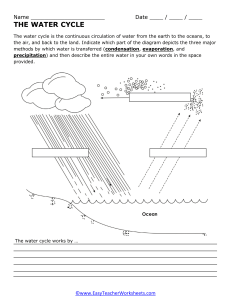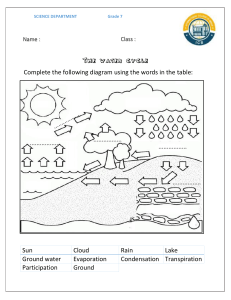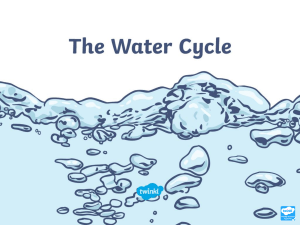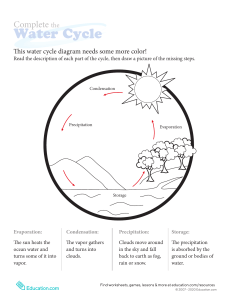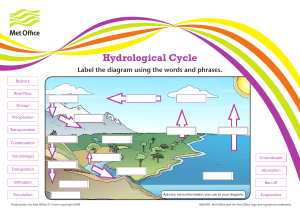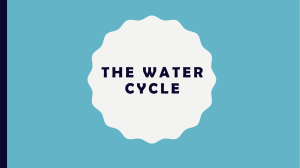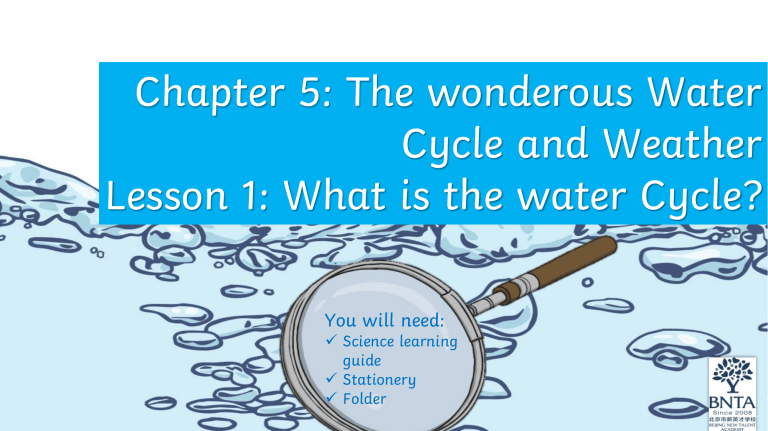
Chapter 5: The wonderous Water Cycle and Weather Lesson 1: What is the water Cycle? You will need: Science learning guide Stationery Folder Rules Quiet when teacher is speaking. Hands up. Speak in English. Work well together. Try your best. Be safe. Today Learning Objective • To understand what is the water cycle. Success Criteria • To know and be able to explain what the water cycle is. • To complete a comprehension activity on the water cycle. NEW TOOL! pipette WHAT’S ON THE TRAY? funnel tripod test tube petri dish graduated cylinder magnifying glass bunsen burner pipette thermometer What are they used for? What are they made of? What are they used for? What are they made of? What are they used for? What are they made of? What is the water cycle? 水循环是什么? The water cycle is the name we give to describe the way water moves throughout planet Earth. The water cycle has two other names: The hydrological cycle The H2O cycle How does the water move in a cycle? The water cycle has four main parts. These are the steps the water goes through when it’s moving through the Earth: 1. Evaporation 2. Condensation 3. Precipitation 4. Accumulation Evaporation 蒸发 This happens when bodies of water like lakes, rivers, and oceans heat up. When the water becomes hot, it forms vapours that go into the air. You might have seen evaporation if you’ve ever boiled water. The water heats up and then the steam rises from the water! Condensation 冷凝 This is the opposite of evaporation. Condensation happens when the vapour in the air gets cold. When the vapour gets cold, it gets transformed back into a liquid form; this is what makes clouds! Precipitation 降水 Precipitation happens when the water that went up into the sky gets released. Depending on the temperature, the water comes down as liquid or solid. Rain: when the water comes down as a liquid. Snow: when the water comes down as a solid. Accumulation 积累 This happens when the water collects in one place and forms a river, lake, or any other body of water! Question: What do you think happens after the water accumulates? Answer: Evaporation The Water Cycle D 1. Evaporation B 2. Condensation C A 3. Precipitation 4. Accumulation Fun facts! 1. The water you drink everyday is the same water that has been around since the Jurassic Period! 2. The sun is necessary in the water cycle: no sun means no evaporation. 3. Only 2.5% of the world’s water is freshwater. Activity 1 – Reading comprehension • You have 7 minutes to go through the text and answer the questions on page 3. • You may work in pairs, make sure everyone in your group has answers. • You may talk, but please keep the noise levels low. • Underline the key information. Activity 1 – Reading comprehension Activity 1 – Reading comprehension 🗸 🗸 evaporation condensation precipitation accumulation Activity 1 – Reading comprehension End of Class Learning Objective • To understand what is the water cycle. Success Criteria • To know and be able to explain what the water cycle is. • To complete a comprehension activity on the water cycle. Next Lesson • We will learn about the more complicated terms of the water cycle. • These are sublimation, groundwater and run-off. • Which do you think they are?

